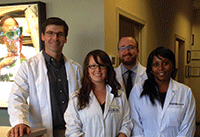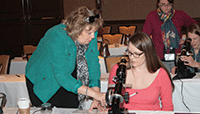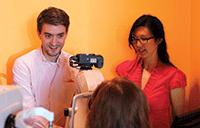Are your optometric technicians certified? If not, should they be?

| |
| Optometrist Summy To, OD, (right) only recently hired a doctor's assistant, Greg McCauley, to provide continuity of care. But she hasn't yet decided if certification is necessary. |
Many private practitioners—and many techs themselves—say that paraoptometric certification offers a lot of pluses: it improves patient care, raises patients’ respect for your practice, bolsters employee loyalty and reduces turnover.
In many practices, optometric technicians have a wide range of responsibilities, including pretesting, visual field testing, retinal photography and imaging, frame and lens selection, adjustments, contact lens insertion and removal instruction, front office management and the triaging of eye emergencies. With all this on their shoulders, shouldn’t they have some sort of formal endorsement or qualification?
On the other hand, some practitioners ask: If you’ve done the in-house training yourself, why jump through hoops for a designation that adds little more than a stamp of approval? And, why encourage or even subsidize the expense to train a tech, who may very well take that experience to a better-paying job at another practice?
Let’s look at both sides of this often overlooked, but important, issue.
Practicing Without ‘Paras’

|
|
|
Alan Bishop, OD, (left) stands behind certification of his staff (left to right): Kristin Klewit, CPO; Alex Carpenter, OD, a CPO-tech-turned optometrist; and Chantay Kittles, a tech currently preparing to take her CPO test.
|
Despite the availability of paraoptometric certification, some optometrists have found that the extensive in-house training that they put newly hired technicians and doctor’s assistants through is enough.
Optometrist Craig Miller of Eye Columbus in Columbus, Ohio, has non-certified optometric assistants as well as opticians scribe for him and perform pretesting. He says that most new techs in each of his two practices typically start with scribing before moving into pre-exam mode and that none of his staff is currently paraoptometric certified.
Why not have techs obtain certification?
“Most staff do not feel that it is a necessary step in order to be productive in their field [and that] the ‘on-the-job’ training that is provided to them combined with professional experience are the keys [to being successful and feeling competent],” Dr. Miller says.
Other optometrists, like Summy To, OD, of Myoptic Optometry in Portland, Ore., have had opticians or the doctors themselves do pretesting, and only recently have found it necessary to add any type of doctor’s assistant. But, she has yet to require the optometric assistant to become certified.
“As we got busier, the opticians were handling more tasks at once, and I was concerned that we could no longer provide the smooth continuity of care our patients deserve while keeping my team focused,” Dr. To says. “Now I have hired a doctor’s assistant to check in patients, answer any questions patients may have and pretest. Afterwards, the doctor’s assistant follows through [with the patients’ continuity of care] by introducing them to opticians, then checking them out and executing any of the doctor’s orders, like calling in medical prescriptions or ordering trial contacts.”
|
The Basics of Certification
“Certification focuses specifically on the individual and is an indication of current proficiency in a specialized field,” says Sharon Alderson, administrator of the CPC. The key words here are “current proficiency” because certified paraoptometrics not only have to pass a test to demonstrate a competent level of knowledge and understanding at each level of certification, they also have to keep up with continuing education that requires them to take a certain number of credit hours every three years in order to keep their certification valid (18 CE hours for those certified as CPO, CPOA and CPOT and 9 CE hours for CPOC.) The continuing education aspect of certification seems to be one of the advantages to entering the ranks of official paraoptometric certification because it enables those certified to maintain their current knowledge base and gives them opportunities to expand it. The CPC says there are about 6,000 individuals currently certified among the four types of paraoptometric certification. Three out of the four types progressively build upon each other: certified paraoptometric (CPO) is the entry level, certified paraoptometric assistant (CPOA) is the next or intermediate level and certified paraoptometric technician (CPOT) is the most advanced level. Certified paraoptometric coder (CPOC), the fourth type of certification, stands independent from the rest because it doesn’t require certification at any other level prior to achieve it. However, there is a minimum of two years’ experience in the field of medical billing and coding required in order to apply to take the CPOC exam. Achieving certification, even at the entry level (CPO), may be challenging for some. To pass the examination, the candidate has to demonstrate a vast understanding of optometric principles and knowledge of instrumentation, anatomy, optics, basic pharmacology and even aspects of practice management. The CPO test consists of 100 multiple-choice questions and there are study bundles available for purchase through the AOA website to help candidates prepare for the test as well as the tests at other levels. Testing at the most advanced level of paraoptometric certification (CPOT) will change beginning November 2014. The exam traditionally consisted of two parts: a 225-question multiple-choice exam and a hands-on practical. But starting this month, the hands-on practical has been replaced with a clinical exam. Candidates must successfully complete both parts of the CPOT exam in order to earn the CPOT title. |
Dr. To says that adding the position of a doctor’s assistant to her practice has helped tremendously because it has “led to less effort on the doctor’s part to find an available body, and more time for each person to devote their undivided attention to whomever they are helping at the time.”
Because the doctor’s assistant only recently came on board, Dr. To hasn’t yet decided whether he needs to be certified.
Upside to Certification
Optometrist Alan Bishop of Easton Eye Care in Easton, Md., has seen firsthand the advantages of his employees achieving certification. One instance was in how well his technicians properly handled the triaging of a patient who called their office on a Saturday with complaints that indicated a retinal detachment.
“[The patient] was concerned about leaving work and coming to the office and also that we did not accept his insurance,” says Dr. Bishop, “[but] our technicians assisted with the triage and explained to the patient that he should not hesitate and should be seen right away. We fit the patient in and he indeed did have a retinal detachment. One of our technicians assisted with contacting a local retinal specialist who immediately performed treatment to save the patient’s vision. If it weren’t for our educated technicians being able to know and understand the urgency and symptoms of a retinal detachment, this patient may not have experienced such efficient and appropriate care.”
There are currently three certified paraoptometric techs on Dr. Bishop’s staff: two CPOs and one CPOA. “It’s important that we have staff with a proven skill set,” says Dr. Bishop. “Being able to have certified staff hopefully shows our patients that we are committed to providing them the best care, the best service and the best experience they can have. Our staff considers what they do a career, not a job.”
Though it may be hard to find certified paraoptometric technicians to hire, Dr. Bishop suggests optometrists should not let that discourage them from striving to have their office become 100% certified.
“Paraoptometrics are not in abundance in our area, therefore we’ve never hired someone already certified,” he says. “We’ve brought staff into our office with exceptional service skills and trained them onsite. Once ready, they’ve registered for certification and passed.”
Although he did not pay for their initial fee to become certified, Dr. Bishop says “they were provided an immediate wage increase upon passing and my practice pays for any subsequent exams.” His certified techs cover their own renewal fees involved with keeping their certification valid, but he does pay for all of their continuing education at Vision Expo East and “the practice has employees registered as associate members of the AOA through myself, therefore entitling them to take up to six CE credits yearly.”
Dr. Bishop encourages other ODs to adopt paraoptometric certification into their own practices. “Certification will emphasize professionalism, earn patient trust and enhance an employee’s own self-image and confidence. I personally feel certification is also a weapon against turnover. Some may think, ‘If I train them, what if they leave?’ But I subscribe to the idea, ‘If I train them, what if they stay?’”
|
Different Types of Paraoptometric Certification
The AOA’s four certified programs for optometric staff accredited by the National Commission for Certifying Agencies include: • Certified Paraoptometric (CPO): entry level Requirements: Minimum of a high school diploma or equivalent AND minimum of six months mentored experience. Fee: $265 • Certified Paraoptometric Assistant (CPOA): intermediate level. Requirements: Minimum of six months additional employment in the eye care field as a Certified Paraoptometric (CPO); or be a graduate or student currently enrolled the last semester of study of a CPC-approved optometric assistant program; or have five years or more work experience in the eye care field and receive approval from the CPC administrator to bypass the CPO exam. The employer must attest to this experience by completing the CPOA Reference Form. Fee: $285, or $215 for students * • Certified Paraoptometric Technician (CPOT): advanced level. Requirements: Minimum of six months additional employment in the eye care field as a Certified Paraoptometric Assistant (CPOA); or be a graduate or student currently enrolled in the last semester of study of an Accreditation Council on Optometric Education (ACOE) approved optometric technician program. Fee: $285 or $215 for students * • Certified Paraoptometric Coder (CPOC): speciality. Requirements: Minimum of a high school diploma or equivalent AND minimum of two years’ experience in the medical coding and billing field. Fee: $265 Application deadlines, details, exam dates and testing center locations can be found on the AOA website ( www.aoa.org/paraoptometrics/certification/apply?sso=y). Handbooks and study bundles for each type of test are available for purchase through the AOA marketplace online. * Student: an applicant who is currently enrolled or has graduated within the past three years from either a CPC- or ACOE-approved program. Documentation required. |
To prove his point, Dr. Bishop relates that one of his former CPO-certified techs is now back on staff—only this time as an optometrist who has since graduated from Salus University.
A Para and an Advocate
Tamara Franklin, CPOT, Chair of the AOA’s Commission for Paraoptometric Certification (CPC), also encourages optometrists to help staff attain paraoptometric certification—like she did herself.

|
|
|
Tami Franklin, CPOT, says certification promotes better patient care. Here, she helps test
candidates prepare for the CPOT exam at a CE review class at SECO.
|
“Paraoptometric certification is a measure that proves that optometric staff have attained a standard level of knowledge to provide patient care,” Mrs. Franklin says. Also, certification “requires them to continue to expand on their competency, which is an integral part of providing a higher level of patient care.”
In addition to serving as chair of the CPC, Mrs. Franklin is also the office administrator at Alliance Vision Source in Alliance, Neb. She says certification promotes better patient care not only through CE, but also through camaraderie. “Certification creates an environment of learning, bringing [with it] higher levels of patient care as a team. My optometrist and I were always a team, with a philosophy of bringing the best patient care to all our patients, no matter what their needs were,” she says. “After I attained my CPOT, I used it not only for the medical side of the practice, but also for continued education in low vision and vision therapy.”
Optometrists play a pivotal role in helping technicians and assistants realize the benefits that formal certification can bring, Mrs. Franklin says. “Often, the optometrist doesn’t realize how influential they can be. Seeking paraoptometric certification should be important to all optometric staff, as well as all optometric physicians,” she says. “I would encourage all optometrists to have a program of continuing education for their staff, which includes a path for those employees to follow to the CPOT level, if they desire.”
Paraoptometric certification is not just good patient care, Mrs. Franklin suggests. It’s also good business. “In our changing health care world, I feel paraoptometric certification is more important now than ever before,” she says.


